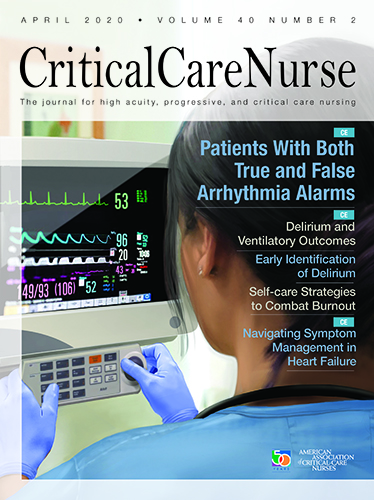A concerted effort to standardize delirium assessment and treatment helped a west Texas hospital reduce the use of high-risk medications and improve the quality of care for critically ill patients, according to a study published in Critical Care Nurse (CCN).
Delirium occurs in at least a third of patients in intensive care units (ICUs) and nearly 80 percent of patients receiving mechanical ventilation. Delirium predisposes patients to longer hospital stays, increased morbidity and mortality, and other negative outcomes, with symptoms that can linger long past their hospital stay.
The journal article, “Early Identification of Delirium in Intensive Care Unit Patients: Improving the Quality of Care,” reviews an evidence-based quality improvement initiative at Covenant Medical Center in Lubbock, Texas.
Lead author Jessica Spiegelberg, DNP, APRN, FNP-C, PMHNP-BC, is an advanced practice nurse at Texas Tech University Health Sciences Center, Lubbock. As part of her clinical practice, she provides psychiatric consultations at Covenant, including assessing behavioral changes in critical ill patients with delirium. For this study, she worked with colleagues at Covenant and TTUHSC, as well as experts from the Center for Critical Illness, Brain Dysfunction and Survivorship at Vanderbilt University Medical Center in Nashville, Tennessee.
“Our project changed clinical practice and resulted in a more judicious use of high-risk medications,” she said. “Identifying patients at risk for delirium and recognizing the symptoms are crucial elements to any prevention or treatment strategy.”
At the onset of the project, the ICU did not use delirium as a standard term and did not use a screening tool to accurately identify delirium. Clinical practice guidelines recommend the routine use of valid and reliable delirium assessment tools, such as the Confusion Assessment Method for the ICU (CAM-ICU) in critical care practice.
A lack of standardized screening also contributed to inconsistency in treatment methods. Symptoms of agitation and increased sedation were typically treated with opioids, benzodiazepines and other high-risk medications (HRMs).
The first phase of the project included development of a multidisciplinary team, baseline data collection and a mix of hands-on training and online education. Pocket cards with delirium risk factors were created, and CAM-ICU documentation was added to the electronic health record (EHR).
During the implementation phase, the CAM-ICU screening tool went live in the EHR critical care standard of care to be completed by nurses once per 12-hour shift for all patients in the 16-bed medical ICU. Nurses were also able to refer to the pocket card for quick information about risk factors, including high-risk medications that contribute to delirium.
Among patients at high risk for delirium, HRM use fell from 4.73% in phase one to 2.99% in phase two. Among patients at low risk, HRM use also significantly decreased from 7.37% in phase one to 3.92% in phase two. Data from 288 patient-stay records provided baseline information for phase one, while 199 patient-stay records were reviewed in phase two.
In addition, the study revealed a noticeable decrease in special cause variation of HRM use, especially for patients with low risk of delirium.
Hospital stays were significantly shorter in patients at low risk than at high risk for delirium but increased by a mean of 0.13 days with each additional high-risk medication used.
Chart review and periodic spot-check evaluations revealed a CAM-ICU completion rate of 83% six weeks after the launch of phase two. The team also discovered work-around options allowing nurses to select “unable to assess” and opt out of the CAM-ICU documentation in the health record. They also noted an unintended consequence that not closing the critical care standard of care flow sheet prior to transferring patients to other units led to its continued use beyond the study parameters.
After the pilot study, the CAM-ICU remained in the critical care standard of care to be completed by ICU nurses for all patients once per shift. Training on the CAM-ICU is now part of new nurse onboarding and an annual ICU review topic.
As the American Association of Critical-Care Nurses’ bimonthly clinical practice journal for high-acuity and critical care nurses, CCN is a trusted source of information related to the bedside care of critically and acutely ill patients.
Access the article abstract and full-text PDF by visiting the CCN website at http://ccn.aacnjournals.org.
About Critical Care Nurse: Critical Care Nurse (CCN), a bimonthly clinical practice journal published by the American Association of Critical-Care Nurses, provides current, relevant and useful information about the bedside care of critically and acutely ill patients. The award-winning journal also offers columns on traditional and emerging issues across the spectrum of critical care, keeping critical care nurses informed on topics that affect their practice in high-acuity, progressive and critical care settings. CCN enjoys a circulation of more than 120,000 and can be accessed at http://ccn.aacnjournals.org/.
About the American Association of Critical-Care Nurses: For more than 50 years, the American Association of Critical-Care Nurses (AACN) has been dedicated to acute and critical care nursing excellence. The organization’s vision is to create a healthcare system driven by the needs of patients and their families in which acute and critical care nurses make their optimal contribution. AACN is the world’s largest specialty nursing organization, with more than 120,000 members and over 200 chapters in the United States.
American Association of Critical-Care Nurses, 27071 Aliso Creek Road, Aliso Viejo, CA 92656;
949-362-2000; www.aacn.org; facebook.com/aacnface; twitter.com/aacnme
Original post https://alertarticles.info
